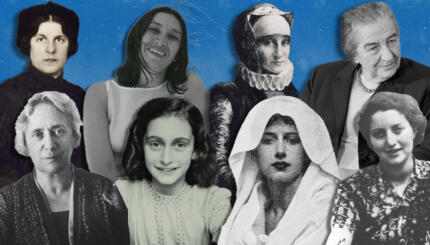This profile first appeared in Hadassah Magazine and is reprinted with permission of the author.
One day in 1835, Henry Clay, the American statesman, heard that a remarkable Jewish woman named Rebecca Gratz was about to visit his hometown of Lexington, Kentucky.
On the day of her arrival he rode to her brother Benjamin’s home, where she was staying, to invite her to dine with him at Ashland, his country estate.
Clay made sure she entered the dining room at his side and that she sat next to him at the table. Their conversation was the sort that “great men talk,” according to the recollections of Gratz’s niece, Sarah Ann Hays.

Help us keep Jewish knowledge accessible to millions of people around the world.
Your donation to My Jewish Learning fuels endless journeys of Jewish discovery. With your help, My Jewish Learning can continue to provide nonstop opportunities for learning, connection and growth.
What had she done to deserve such an honor?
Redefining Jewish Life
By the close of the Colonial era it was becoming increasingly clear that Old World Jewish communal activity–male leadership geared to a more inward-directed Jewish existence–was inappropriate to life in a young nation born of religious freedom and assimilation. New organizations would be needed to foster Jewish learning, values and philanthropy while helping the growing number of immigrants make the most of the opportunities before them.
Among the most influential visionaries to promote this concept was Rebecca Gratz. She became the founder of the American-style “Hebrew school,” as we know it today, and also developed the prototype for many women’s charitable organizations that have become an integral part of American Jewish life.
 And she did so while leading an assimilated life of upper-class refinement. Dianne Ashton, her biographer, observes that Gratz demonstrated that a Jewish woman could be “both fully Jewish and fully American.” And in the process Gratz also showed that there was an important public role for women to play in American Jewish life….
And she did so while leading an assimilated life of upper-class refinement. Dianne Ashton, her biographer, observes that Gratz demonstrated that a Jewish woman could be “both fully Jewish and fully American.” And in the process Gratz also showed that there was an important public role for women to play in American Jewish life….
Assimilated but Affiliated
Born in 1781 in Lancaster, Pennsylvania, during the Revolutionary War, Gratz was the seventh of 10 children who survived into adulthood. Early on, the family moved to Philadelphia, the booming center of a new nation.
Her parents, Miriam Simon Gratz and Michael Gratz, were already living as a merchant family of means. They had been accepted as equals among their Christian neighbors, even participating in some of the city’s leading organizations. This was not unusual for a well-to-do Jewish family prior to the mass migration of Jews at the end of the 19th century. In fact, only three of their children, all girls, would grow up to marry Jews.
Still, her parents continued to honor their Jewish customs and were among the most prominent members of Mikveh Israel, one of Philadelphia’s earliest synagogues. A trickle of incoming German Jews, like Michael Gratz fleeing a restricted life in the Germanic states, had started to mingle with the established community. The Gratzes wanted their children, including the five girls, to receive a solid education. Rebecca was among the most intelligent and the most committed to her ancestral faith….
Despite strong feelings for her faith and the destiny of the Jewish people, virtually none of her suitors were Jewish. Rather, she fell deeply in love with Samuel Ewing, a non-Jewish lawyer and son of the provost of the University of Pennsylvania. But nothing came of it, possibly because intermarriage was one step she could not take.
She hints of this ambivalence in a letter to a non-Jewish sister-in-law immediately after her brother’s marriage to the woman. “Ben should not have made you acquainted with my wishes when it was too late to have them gratified,” she writes to Maria Gist Gratz. “Henceforth we will not remember that there is a difference of opinion… and I trust we will be sincere friends.” They were.
Her rejection of Ewing did not mean she did not love him. When he died decades later, Gratz went into the room where his body lay, leaving three white roses and her miniature on his heart.
The legend gained even more powerful wings after Sir Walter Scott was reputed to have based the beautiful Jewish woman in Ivanhoe on Gratz. Scott’s Rebecca with “the superb arch of her eyebrows, her well-formed aquiline nose, her teeth as white as pearl and the profusion of her sable tresses” is lovingly compared with “the proudest beauties of England and is ‘keen-witted’ too.” But Scott’s noble and virtuous Rebecca refuses to marry out of her faith, despite temptations. Gratz neither contradicted nor directly confirmed the parallels, although flattered by the suggestion.
Ewing once told a friend that Gratz was “a woman who swears she never will be married.” And Gratz would argue that from what she saw of marriage, it was a state that brought little happiness. “Better to wander alone through the neglected path of single life,” she once wrote, “than with an ungenial companion.”
Life of Service
Instead, she threw herself into a lifelong commitment to others, creating a power base that in those days only came from remaining single. “That which you call the misfortune of single ladies,” she explained in a letter to a sister-in-law, featured in Letters of Rebecca Gratz (Jewish Publication Society), edited by David Philipson, “is in my case converted into a blessing.”
She also became the homemaker for her three brothers and a sister who remained single, too. Gratz gained some of her grounding in Jewish education as she immersed herself in the upbringing of the 27 children of those siblings who did marry, including the six of her sister Rachel, whom she raised after an early death took their mother.
Gratz’s service to the community started early. In 1801, when she was 20, she joined her mother and a sister in founding Philadelphia’s first nondenominational women’s philanthropy. Bringing women of different religions together was a major break with tradition.
The Female Association for the Relief of Women and Children in Reduced Circumstances became the model for her future groups. Led and managed entirely by women, the position of treasurer was restricted to an unmarried woman so that nobody’s husband could gain control of their funds (at the time men had complete power over the property of their wives).
Gratz took the position of secretary, as she would do repeatedly, enabling her to personally oversee every detail, handle all correspondence (she was an excellent writer) and manage public pleadings. Fourteen years later, several members, including Gratz, decided to create the Philadelphia Orphan Society as a response to a tangential problem that needed to be separated from the larger mission.
Countering Missionaries
Meanwhile, Gratz was observing with alarm as evangelical groups were reaching out with ever-increasing fervor to bring an irreligious nation back into the Christian fold. Philadelphia was experiencing an influx of destitute Jewish immigrants who were falling prey to these messages and the charity that went with them.
Together with a handful of Jewish women friends, Gratz decided it was high time for the Jewish community to respond in kind. The result was twofold: the Female Hebrew Benevolent Society in 1819, designed to provide aid and education separate from congregational life; and, somewhat later, the birth of the first independent Jewish Sunday School–Gratz borrowed the term from the Christian model.
One of the evangelicals’ most pervasive initiatives had been the development of a Christian Sunday School movement, which was attracting parents by offering to any child basic reading instruction virtually free of charge, along with the tenets of its faith. Similar schools were unavailable to Jewish children–the only reading and religious training being the age-old instruction in Hebrew and the language of the immigrant, such as German, given by rabbis to boys. Girls were excluded.
Gratz was hopeful that, as she put it, her type of education–given in English by lay educators—would “lead to some good and induce wiser and better Jews” who could more readily cope with American life.
Experimenting first by providing religious education to her sister’s children, Gratz developed a format and the initial curriculum. Taught primarily by women rather than rabbis, the school opened in 1838 on March 4, Gratz’s birthday. She served as superintendent for more than 20 years.
The impact of the evangelicals was also creating difficulties for Jewish orphans and children needing a temporary home. Gratz argued that they needed their own institution that would not proselytize while protecting. By 1855 she had garnered sufficient funds to develop the Jewish Foster Home in Philadelphia, the first such orphanage in the United States. Her reputation had grown so potent that she was being invited to counsel Jewish women in cities including Richmond, Lexington, and New York on how to start similar institutions.
Outliving most of her friends and close relatives, Gratz died in August 1869 at the age of 88. Her brother, Hyman, left funds for the founding of a teachers’ college for Jewish education. Developed in 1895 as the first of its kind–and known appropriately as Gratz College–it continues its mission in Philadelphia today, a fitting tribute to a model Jewish leader.


